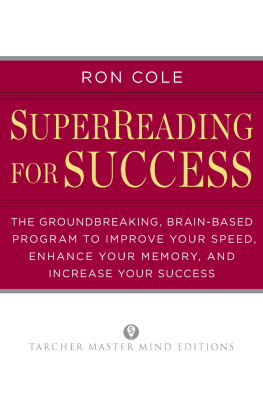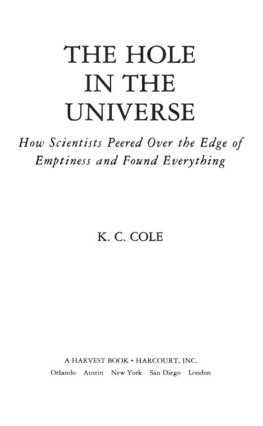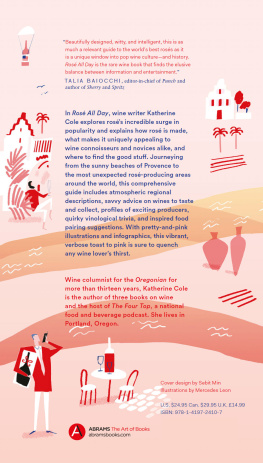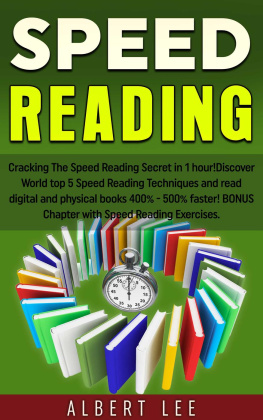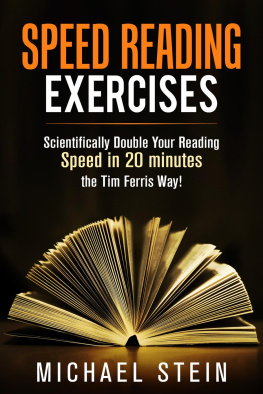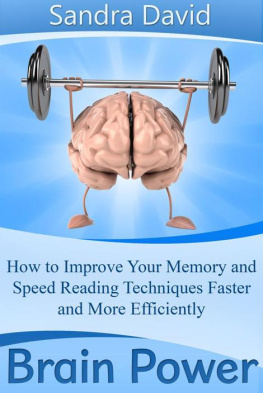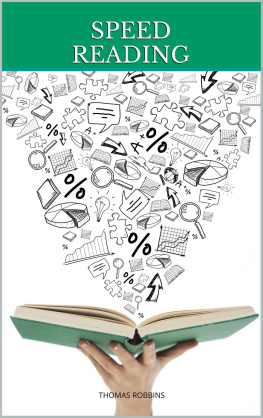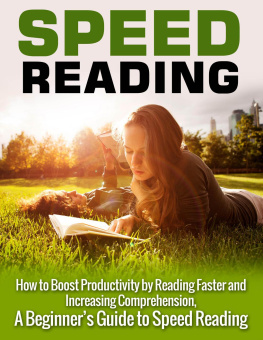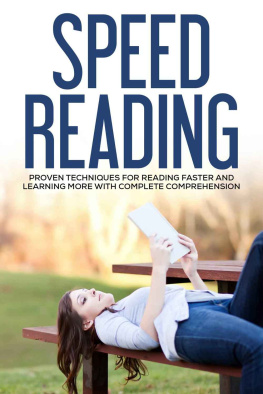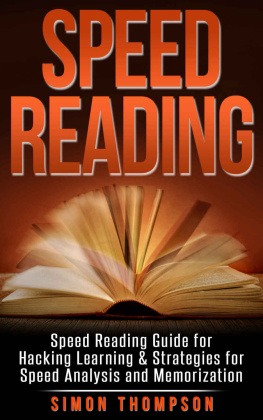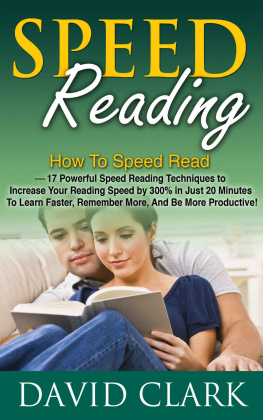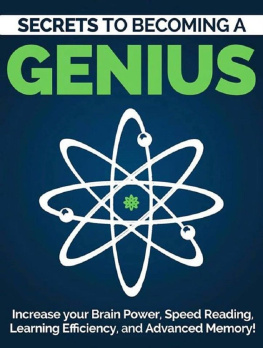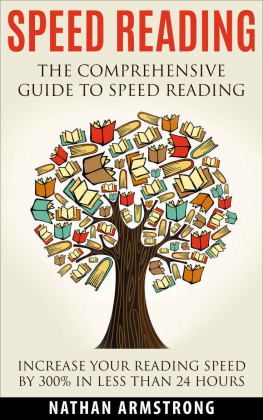
JEREMY P. TARCHER/PENGUIN
Published by the Penguin Group
Penguin Group (USA) Inc., 375 Hudson Street, New York, New York 10014, USA Penguin Group (Canada), 90 Eglinton Avenue East, Suite 700, Toronto, Ontario M4P 2Y3, Canada (a division of Pearson Penguin Canada Inc.) Penguin Books Ltd, 80 Strand, London WC2R 0RL, England Penguin Ireland, 25 St Stephens Green, Dublin 2, Ireland (a division of Penguin Books Ltd) Penguin Group (Australia), 250 Camberwell Road, Camberwell, Victoria 3124, Australia (a division of Pearson Australia Group Pty Ltd) Penguin Books India Pvt Ltd, 11 Community Centre, Panchsheel Park, New Delhi110 017, India Penguin Group (NZ), 67 Apollo Drive, Rosedale, North Shore 0632, New Zealand (a division of Pearson New Zealand Ltd) Penguin Books (South Africa) (Pty) Ltd, 24 Sturdee Avenue, Rosebank, Johannesburg 2196, South Africa
Penguin Books Ltd, Registered Offices:
80 Strand, London WC2R 0RL, England
Originally published in the United Kingdom as
How to Be a Super Reader by Piatkus in 2009
First American edition published by Tarcher/Penguin in 2012
Copyright 2009 by Ron Cole
All rights reserved. No part of this book may be reproduced, scanned, or distributed in any printed or electronic form without permission. Please do not participate in or encourage piracy of copyrighted materials in violation of the authors rights. Purchase only authorized editions.
Published simultaneously in Canada
Most Tarcher/Penguin books are available at special quantity discounts for bulk purchase for sales promotions, premiums, fund-raising, and educational needs. Special books or book excerpts also can be created to fit specific needs. For details, write Penguin Group (USA) Inc. Special Markets, 375 Hudson Street, New York, NY 10014.
ISBN: 978-1-101-60134-1
While the author has made every effort to provide accurate telephone numbers, Internet addresses, and other contact information at the time of publication, neither the publisher nor the author assumes any responsibility for errors, or for changes that occur after publication. Further, the publisher does not have any control over and does not assume any responsibility for author or third-party websites or their content.
ALWAYS LEARNING
PEARSON
Acknowledgments
In mostly chronological order, I wish to thank:
The Roman scholars who came up with the concept of the room.
Evelyn Wood for getting the ball rolling with speed reading.
Shanna McBain for putting in a good word for me at Hewlett-Packard.
Mariam Ghazvini for giving the course a chance at Hewlett-Packard, and championing it through the lean years.
Judy Peterson, whose continued enthusiasm at Xilinx was brilliant.
Bonita Steers for suggesting that the testing could be improved.
Reto Stamm for making Eye-Hop accessible to everyone.
Jackson Chow for continuing to support SuperReading for students.
Claire de Than for her steadfast belief in the project and her desire to help her law students.
Dr. Ross Cooper for his support and professionalism in evaluating the SuperReading course for dyslexics, and spurring great ideas for improving the testing procedure.
Don Schloss for promoting SuperReading among the dyslexic population.
Doreen Montgomery for finding a super publisher.
Anne Lawrance for believing in SuperReading and fully supporting this project.
Carol Franklin for brilliant editing and determining the best order of topics.
All the educators and decision makers who approved SuperReading to be taught.
All my students for taking a chance, giving it a go, and proving time and again that the techniques work.
PART ONE:
Starting Out
The lowdown on
SuperReading
T here are probably several reasons why you want to be a super reader. You may have stacks of reports you need to get through, you may be drowning in e-mails, you may be studying for exams or you may have problems keeping focused. Whatever your reasons are for buying this book, my goal is to help you become a highly effective, confident reader. If you work your way through the advice in this book you will learn how to understand what you read and remember what you need.
In simple terms, you will be able to handle any reading assignment that comes your way intelligently, enthusiastically and efficiently. In the days and weeks ahead you will change your attitude toward reading. Whether you love reading or you dread it, your improved skills will make reading something you will always look forward to. Also, you will learn how to use memory tools that will help you retain any information for as long as you wish.
If reading is a chore for you, take heart. Just a couple of days after picking up this book you will already be reading better. It has been written in a conversational and humorous tone, as if Im talking to you. If you can simply invest a little time each day, I promise you that your abilities will quickly improve.
Whats the SuperReading story?
This book is based on the highly successful SuperReading course that I have been teaching for over 14 years. So, how did it all come about? Back in the mid-1990s I was a life coach coaching clients to have more success in their work. Some of my clients were concerned about where their time was going. They told me they would get to work, start work on a couple of projects and suddenly it was lunchtime. Before they knew it the day was over. Where had all their time gone and why had they accomplished so little? To find out, I asked them to track their time on paper every 30 minutes of the working day. We discovered that time, apart from the unavoidable amount spent traveling, was disappearing into two main areas: meetings and reading. For the first area, I gathered information on running a tidy meeting, with tools like deciding in advance how long to give each topic, assigning a time keeper and ending the meeting at the time that was agreed upon, no matter what.
Then there was reading. What could be done? One option we considered was to hire someone else to read material and provide an executive brief highlighting the main points. The problem was that important items could be missed or misinterpreted. Another option was to transcribe written work to audiotape, but focusing on what is being said can be difficult, going back over bits youve missed is cumbersome and it can take even longer than reading. Or, of course, they could just ignore the material. Unfortunately, that could have serious consequences. As one client, a manager at Sun Microsystems, said: Fifteen years ago I could just go to trade shows and keep up to date on the industry. Ten years ago I could read quarterly synopses of what was happening and not fall behind. Five years ago I could just about get away with monthly newsletters. Now that the industry has become so competitive and fast-paced, and Im a high-level manager making multi-million-dollar decisions, I need information almost daily because things can change so quickly. I must be totally up to date or we could lose millions. And I cant trust anyone else to know what I need. Thats why I took this course.
I looked into speed reading to see if that would help. It was sort of OK for novels, but for business or legal reading it just didnt help people to get everything they needed and not miss important points. So I experimented. I got people together and tried various techniques. The techniques that were successful went on to form the backbone of the SuperReading course. While SuperReading is related to speed reading, this book focuses on comprehension first. I feel that going fast is meaningless if you do not understand what youve read and cannot recall it. Traditional speed reading courses get you to skip words and sometimes whole sections of what you are reading. With SuperReading you do not have to do that. You will read every word and understand it while going faster and faster over time.

